
Genista is a genus of flowering plants in the legume family Fabaceae, native to open habitats such as moorland and pasture in Europe and western Asia. They include species commonly called broom, though the term may also refer to other genera, including Cytisus and Chamaecytisus. Brooms in other genera are sometimes considered synonymous with Genista: Echinospartum, Retama, Spartium, Stauracanthus, and Ulex.

Hypericum aegypticum is a species of flowering plant of the St. John's wort family (Hypericaceae) which is native to the Eastern Mediterranean. It was described by Carl Linnaeus in the second volume of his Species Plantarum in 1753, who named it after Egypt despite it not being distributed there. The plant is commonly known as shrubby St. John's wort or Egyptian St. John's wort in English. Like other members of section Adenotrias, it is found among limestone rocks in coastal areas. While it has been evaluated as threatened on the island of Malta, the species has no legal protections.
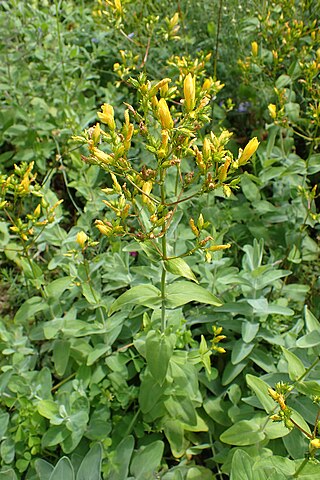
Hypericum annulatum is a species of flowering plant in the family Hypericaceae. It is a perennial herb of varying heights which grows upright, with more than a hundred flowers of a golden yellow color. First described in 1827, the species has a wide distribution from Eastern Europe to East Africa, and its appearance can vary greatly based on its geographic location. It has been used in Bulgarian folk medicine, and has more recently been investigated for its effectiveness in slowing the growth of or killing certain types of human cancer.
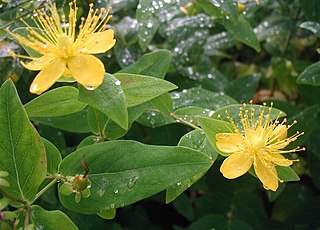
Hypericum hircinum is a species of perennial flowering plant in the St John's wort family, Hypericaceae. It is known as goat St John's wort and stinking tutsan; both names refer to the plant's distinctive odor. The species is a bushy shrub that can grow up to 1.5 meters tall, is many-stemmed, and has golden yellow flowers with conspicuous stamens. The plant has been well-documented in botanical literature, with mentions dating back to at least 1627. Carl Linnaeus described H. hircinum several times, including in his 1753 Species Plantarum which established its binomial. At one point the plant was placed into the defunct genus Androsaemum, but it was returned to Hypericum by Norman Robson in 1985.
Hypericum pubescens is a perennial herb in the Hypericaceae family. It is in the section Adenosepalum.
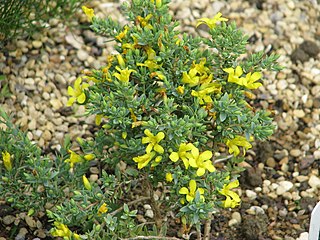
Adenotrias is a section of flowering plants in the family Hypericaceae. It is made up of Hypericum aciferum, H. aegypticum, and H. russeggeri. When it was first described, it was considered its own independent genus, but was later placed under Hypericum and demoted to a section. Its Latin name Adenotrias is made of the Greek prefix adeno- and the Latin word trias. Species in the section are shrubs up to 2 metres (6.6 ft) tall with smooth leaves and bark, and are the only species in Hypericum with heterostylous flowers. They are found around the Mediterranean coast, with H. aciferum restricted to the island of Crete and H. russeggeri present only in parts of Turkey and Syria. Plants of the section have a habitat among limestone and other calcareous rocks. While H. aegypticum has a wide and generally secure distribution, H. aciferum was evaluated as endangered several times since the 1980s, although it is now considered only vulnerable because it is protected in part by a plant micro-reserve near Agia Roumeli.
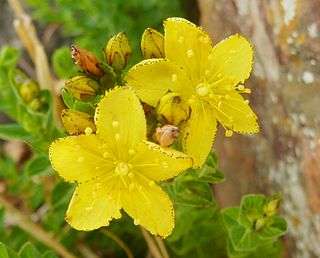
Hypericum aethiopicum is a perennial herb in the genus Hypericum, in the section Adenosepalum. It is the type species of subsect. Aethiopicum.

Hypericum sechmenii, or Seçmen's St John's wort, is a rare species of flowering plant of the St John's wort family (Hypericaceae) that is found in the Eskişehir Province of central Turkey. It was first described in 2009 by Turkish botanists Atila Ocak and Onur Koyuncu, who named the species in honor of Özcan Seçmen, a fellow botanist. They assigned the species to the genus Hypericum, and Norman Robson later placed H. sechmenii into the section Adenosepalum.

Hypericum formosissimum is a species of flowering plant in the St John's wort family Hypericaceae. Found in the cracks of limestone rocks, it is a small perennial herb that grows in a pillow-like shape, has yellow flower petals, and blooms in the late summer. The plant is rare and has a limited habitat in Turkey, Armenia, and Azerbaijan. It is threatened by rock collapses, urbanization, and road construction; it is not protected by conservation efforts.

Hypericum huber-morathii is a species of flowering plant in the St John's wort family Hypericaceae. It is a small perennial herb with few stems. It has narrow and brittle stems, thick leaves, flowers in clusters of varying numbers, small yellow petals, around twenty stamens, and three styles. H. huber-morathii is closely related to H. minutum and H. sechmenii, and also shares characteristics with H. lanuginosum. The plant is endemic to Turkey, and is found among limestone rocks in a limited region of southwestern Anatolia. Originally excluded from a comprehensive monograph of Hypericum, the species' placement within the genus is unclear. It has been placed in both section Adenosepalum and section Origanifolium.
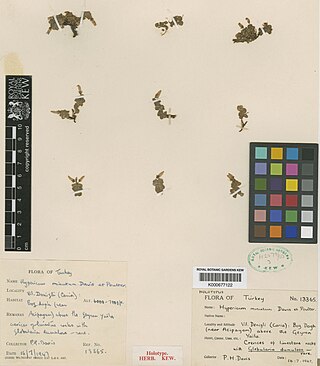
Hypericum minutum is a species of flowering plant in the St John's wort family Hypericaceae. It is a small perennial herb that grows in tufts. It has slender and brittle stems, flowers in clusters of one to three, yellow petals with black and amber glands, few stamens, and a seed capsule with narrow grooves. H. minutum is closely related to H. huber-morathii and H. sechmenii and resembles a smaller form of the latter plant. The plant is endemic to Turkey, and is found among limestone rocks in a limited region of southwestern Anatolia. Originally excluded from a comprehensive monograph of Hypericum, the species' placement within the genus is unclear. It has been placed in both section Adenosepalum and section Origanifolium.

Hypericum collenetteae is a species of flowering plant of the St. John's wort family (Hypericaceae) that is found in Saudi Arabia.

Hypericum coadunatum is a species of flowering plant of the St. John's wort family (Hypericaceae) that is found in the Canary Islands.
Hypericum psilophytum is a species of flowering plant of the St. John's wort family (Hypericaceae) that is found in Morocco and Algeria.
Hypericum scruglii is a species of flowering plant of the St. John's wort family (Hypericaceae) that is found in Sardinia.
Hypericum somaliense is a species of flowering plant of the St. John's wort family (Hypericaceae) that is found in Somalia.

Hypericum tomentosum is a species of flowering plant of the St. John's wort family (Hypericaceae) that is found in the western Mediterranean.
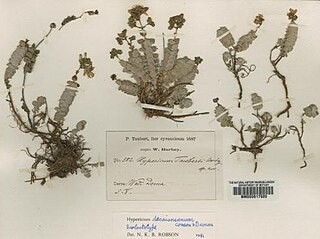
Hypericum decaisneanum is a species of flowering plant in the St John's wort family Hypericaceae. Named for French botanist Joseph Decaisne, it is a small perennial herb that grows mostly upright. It has thick, papery leaves and up to twenty flowers with bright yellow petals. Endemic to the Jebel al Akhdar province of Libya, H. decaisneanum is found in the cracks of limestone rocks on steep escarpments. It is a member of numerous plant communities and associations of chasmophytes, of which it is sometimes a key species. First described in 1899, the species was originally placed in section Taeniocarpium of the genus Hypericum, but more recently it has been considered a member of section Adenosepalum.


















